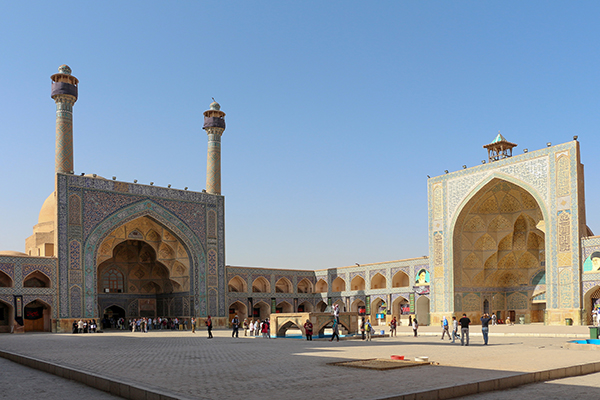Rethinking Classicism: Safavid Dynasty
Today's Rethinking Classicism post brings us to the city of Isfahan, Iran. The Safavid dynasty (1501–1736) was a cultural pinnacle in Persian history. The Safavid rulers were massive patrons of the arts, including painting, book illustration, and architecture, all of which peaked in refinement during their rule. After 900 years of disunited and foreign (Seljuk Turk and Mongol) rule, the Safavid dynasty united Iran under Shiism. The rule of 'Abbas I (1571–1629, ruled 1588–1629) marked the highpoint of the Safavid period.
 |
| Safavid Dynasty, Jamēh Mosque (Great Mosque), Isfahan, Iran, mostly 700s to 1600s. Photo by Bernard Gagnon. CC BY-SA 4.0. (8S-10023) |
'Abbas moved the capital from the vulnerable western border established by the Mongols back to Isfahan in central Iran in 1598, extending the city south of the existing city limit. In order to shore up Safavid influence and prestige, 'Abbas planned a massive building program in the city, erecting some of the most beautiful structures in Islam and making additions to existing Seljuk structures. Succeeding shahs continued the building programs in Isfahan up until the disastrous reign of the Safavid's last ruler, Sultan Hossein Safavi (ca. 1668–1726, ruled 1694–1722). The architectural renovations the Safavids made in Isfahan have become archetypal images of the unique beauty of Islamic architecture.
The Seljuk rebuilding of the Great Mosque included an emphasis on a domed central area of worship (visible behind the minarets) and a redistribution of visual attention to the central courtyard. The four iwans (or ayvan, monumental, often projecting portals) of the courtyard, though not a Seljuk invention, established a more logical flow between open courtyard and prayer hall than in the previous rigid hypostyle plan. During the Safavid period, before Isfahan was made the capital, embellishments continued to be showered on the Great Mosque.
Under 'Abbas, the iwans in the courtyard each received complex muqarnas vaulting (or elaborations on existing ones) with glazed tile mosaic work. Muqarnas are a type of honeycomb vault that consist of multiple subdivided squinches. The principal south iwan, which led to the qibla (the direction to face Mecca), received two thin minarets. The Safavid love of glazed tile mosaic decoration of the Great Mosque was a great contrast to the previous Seljuk preference for bare brick.


Comments